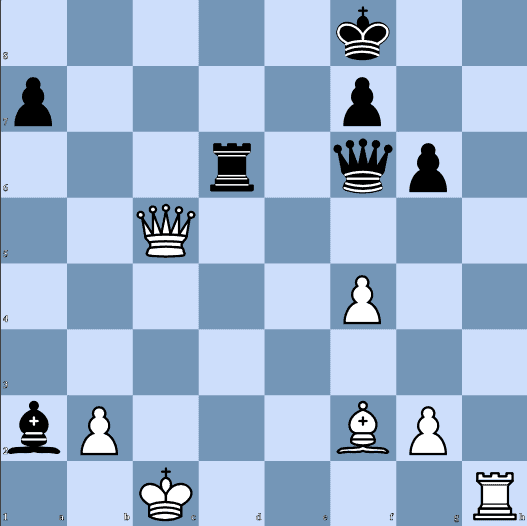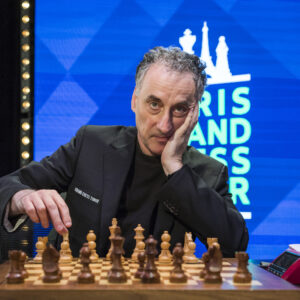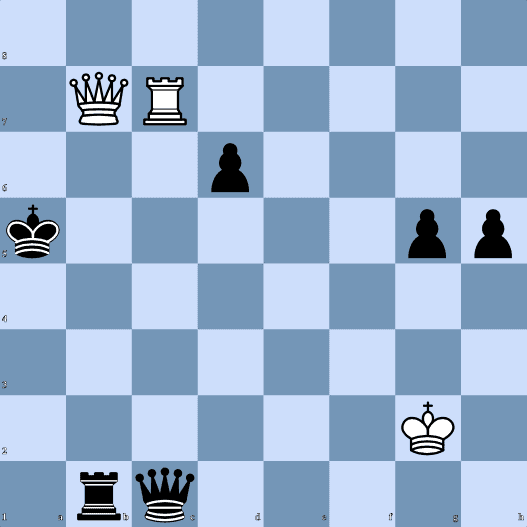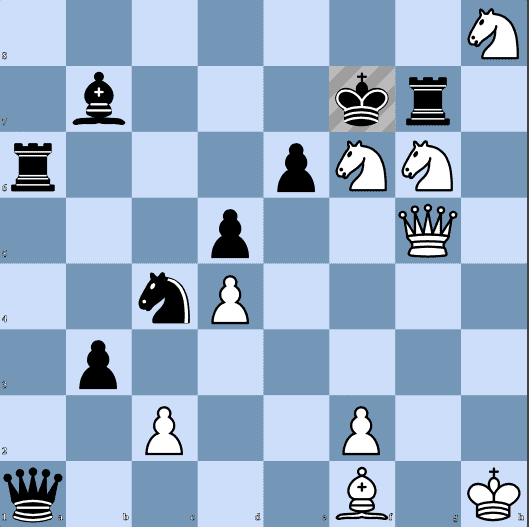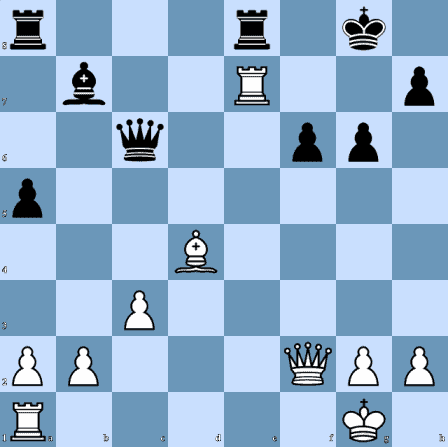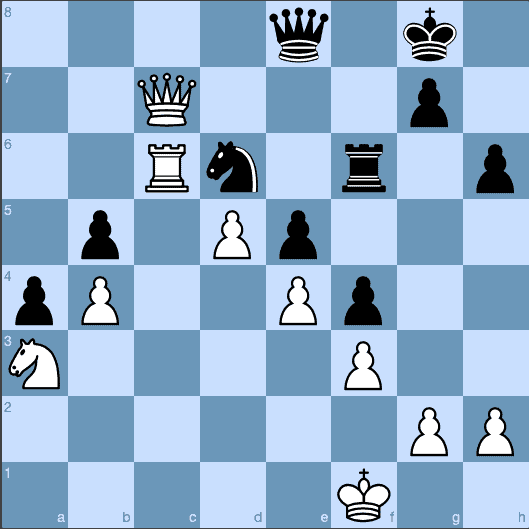Today we present another cornucopia of delights from Malcolm Pein’s Daily Telegraph chess columns. Immerse yourselves in games from around the globe and test your own chess powers along the way.
Too Quiet
IF YOU need to keep the draw in hand with white, choosing an opening variation that allows you to simplify by opening a central file at an early stage to facilitate exchanges of rooks is ideal.
Although, as we saw in last week’s column, there are no guarantees, as Ravi Haria overcame Etienne Bacrot with black in an Exchange French Rapid play-off game at the FIDE World Cup after 1.e4 e6 2.d4 d5 3.exd5 exd5.
One opening suited to playing for the win with black is the Pirc or Modern Defence, as it minimises contact for the first few moves. One of the most solid counters is a set-up favoured by the chain- smoking Russian grandmaster Efim Geller (1925-1988). White is ready to answer any attempt to contest the centre with a pawn exchange.
J. Xiong – B. Adhiban
Chess.com PRO League 2020
Pirc Defence
Geller’s Quiet System 3+1
1.d4 Nf6 2.Nf3 g6 3.Nbd2 Bg7 4.e4 d6 5.Bd3 0–0 6.0–0 Nc6 7.c3 e5 8.dxe5 Nxe5 (It looks odd to exchange knights, but this frees Black’s position and allows him to defend d5 with c7-c6 if required) 9.Nxe5 dxe5 10.Nc4 Nh5 11.g3 Bg4 (Xiong had previously faced 11…Qe7 and 11…Bh3. Provoking f2–f3 turns out to be very useful. If White wanted a draw, then 12.Be2 would do the job) 12.f3 Bh3 13.Re1 Qe7 14.Qe2 Rad8 15.Be3 Rd7 16.Rad1 Rfd8 17.Na5?!
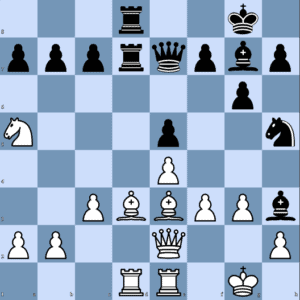
(White gets ambitious. After 17.Bc2 White’s minor pieces are somewhat better placed) 17…Nf4!! 18.gxf4 exf4 19.Bxf4 (19.Bf2?? Qg5+ wins. The computer proposes 19.Nxb7 Qg5+ 20.Kh1 Rxd3 21.Rxd3 Rxd3 22.Bxa7 and one plausible outcome would be 22…Rd7 23.Rg1 Qh5 24.Nc5 Rd2 25.Qxd2 Qxf3+ 26.Rg2 Qf1+ 27.Rg1 Qf3+ =) 19…Qc5+ 20.Qf2 Qxa5 (Black has the safer king and a slight initiative but the end comes remarkably quickly) 21.Qh4 Qb6+ 22.Be3 Qxb2!! 23.Qxh3 Qxc3 (White must lose a bishop and the game) 24.Qh4 (24.Bc2 Rxd1 25.Rxd1 Qxe3+ or 25.Bxd1 Qxe1+) 24…Bf6 25.Qf4 Rxd3 26.Rc1 Rxe3 27.Qxe3 Qxe3+ 28.Rxe3 Bg5 29.Rec3 Bxc1 30.Rxc1 c6 31.Rc2 Kf8 32.Kf2 Rd3 0–1
Test Your Strength
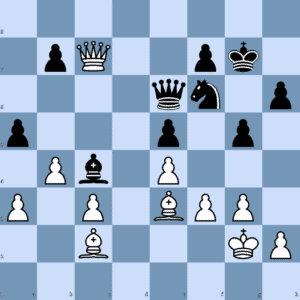
Andersson-Hartston, Hastings 72/3 in the same opening line with 10.Qe2 Bh6. White has just grabbed the c7 pawn.
Black to play and win
Highlight the space below this line to reveal the answer.
36…Qh3+! 0-1 37.Kxh3 Bf1#
Failing the Test
Garry Kasparov’s The Test of Time, published in 1986, was a brilliant work. It contained Garry’s annotations, before computer analysis, of his games from the beginning of his career, to just before he defeated Anatoly Karpov in 1985 to become world champion. Two weekends ago, time caught up with Garry when he took on nine of the world’s best players in the GCT Blitz at Zagreb.
It was a disaster; the 13th world champion’s beloved Sicilian Najdorf took several beatings and he could only score 2.5/18.
J. Van Foreest – G. Kasparov
Sicilian Najdorf 3+2
1.e4 c5 2.Nf3 d6 3.d4 cxd4 4.Nxd4 Nf6 5.Nc3 a6 6.Bg5 e6 7.f4 Qc7 8.Bxf6 gxf6 9.Qf3 b5 10.a3 Nc6 11.Nxc6 Qxc6 12.f5 Qc5 13.Be2 Ra7 14.0–0–0 Qe5 15.Rhf1 Rc7 16.Kb1 h5 17.h4 Be7 18.Qe3 Qc5 19.Qg3 Kf8 20.fxe6 fxe6 21.Qg6 Qe5 22.Rd3 Bd8 23.Rg3 Rf7
Test Your Strength
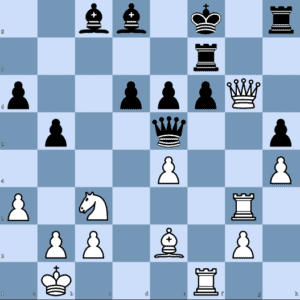
White to play and win
Kasparov’s only win:
G. Kasparov – J. Van Foreest
Scotch Game 3+2
1.e4 e5 2.Nf3 Nc6 3.d4 exd4 4.Nxd4 Nf6 5.Nxc6 bxc6 6.e5 Qe7 7.Qe2 Nd5 8.c4 Qb4+ 9.Nd2 Nf4 10.Qe3 Ng6 11.Bd3 Bc5 12.Qg3 0–0 13.0–0 d6 14.Nb3! (The bishops are well worth a pawn) 14…Nxe5 15.a3 Qb6 16.Nxc5 Qxc5 17.Be3 Qa5 18.b4 Qa4 19.Bd4 f6 20.Bxe5 (20.Be4 Bd7 21.Qc3 intending f4 also looks good) 20…fxe5 21.f4 Bf5 22.fxe5 Bxd3 23.Qxd3 dxe5 24.Qd7 (White has enough play for the pawn) (Black does not want to exchange queens and he loses a second pawn, but even after 31…Qxc5 32.bxc5 e4 33.a4
Kg8 34.a5 Ra8 35.c6 wins the e4 pawn, if 35…Rf7 36.Rxe4) 32.Qxe5 Qb3 33.Qe3 Qc4 34.Rac1 Qf7 35.Qg3 h6 36.b5 Qd5 37.a4 (37.Rc7!) 37…Rxa4 38.Rb1 Rf5 (38…Ra7 hangs on) 39.b6 Rg5
Test Your Strength
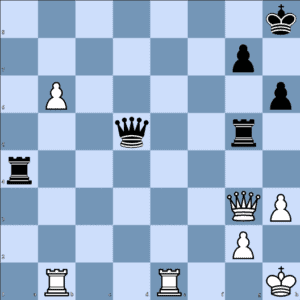
White to play and win
Highlight the space below this line to reveal the answers.
Answer One: 24.Rg5! Qd4 (24…fxg5 25.Qxf7#) 25.Bxh5 1–0
Answer Two: 40.b7! Qxb7 41.Qxg5 1-0 41.Re8+ Kh7 42.Qd3+ also works.
Battle Royal
A MAGNIFICENT fight between Radoslaw Wojtaszek and Magnus Carlsen that ended in a draw was the highlight of the fourth round first-leg matches at the FIDE World Cup. Poland’s second ranked player fearlessly sacrificed a piece and, when the world champion replied in kind, Wojtaszek gave up his queen.
Carlsen offered a draw with just two minutes on his clock in an unclear position to seek his chances in the return game where he plays white. It’s been a good World Cup so far for Poland with Jan-Krzysztof Duda and Kacper Piorun also in the last 32.
Half of the 16 games ended decisively, as Uzbek prodigies Nodirbek Abdusattorov and Javokhir Sindarov were left needing wins on demand with black in the second leg.
R. Wojtaszek – M. Carlsen
Catalan
1.d4 Nf6 2.c4 e6 3.g3 d5 4.Bg2 Be7 5.Nf3 0–0 6.0–0 a5!? (Rare, but useful if Black wants to gain space on the queenside or support a knight on b4) 7.Qc2 c6 8.Nbd2 b6 9.e4 Bb7 10.Rd1 Na6 11.e5 Nd7 12. cxd5 Nb4 13.Qb1 cxd5 14.Nf1 Ba6 15.Ne3 Rc8 16.a3 Nc6 17.b3 b5 (Chances are about equal, White has more space and scope for kingside expansion, Black can probe on the queenside) 18.h4 b4! 19.a4 Be2 20.Rd2 Bxf3 21.Bxf3 f6! (A great idea, Black weakens, then attacks e5) 22.Bg4 (22.exf6 Nxd4! 23.Rxd4 Bxf6 24.Nf5 Kh8 25.Bb2 Be5! is better for Black or if 24.Bb2 Bxd4 25.Bxd4 Rxf3) 22…f5 23.Nxf5 (If 23.Bh3 Bxh4 anyway 24.gxh4 Qxh4 25.Bg2 f4 is too strong) 23…exf5 24.Bxf5 Bxh4! 25.gxh4 Qxh4?! (25…Ncxe5! 26.dxe5 Nxe5 27.Kg2! Qxh4 28.Bxc8 Qg5+ 29.Kf1 Nf3 is very strong. One threat is Qe1+ Ke2 Qe1+ Kd3 Qe4#. Black wins back a rook, and White’s dormant pieces cannot protect his king) 26.Be6+ Kh8 27.Qd3 Ndxe5 28.dxe5 Nxe5 29.Qxd5! Nf3+
Test Your Strength
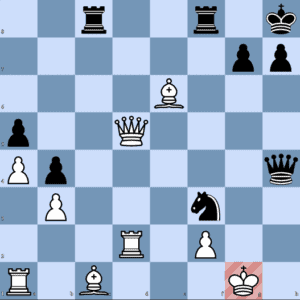
Calculate the mate after 30.Kg2
30.Qxf3! Rxf3 31.Bxc8 Rf8 32.Bb7 Qf6 (32…Re8 33.Kf1! saves the day and not 33.Bb2 Qg5+)
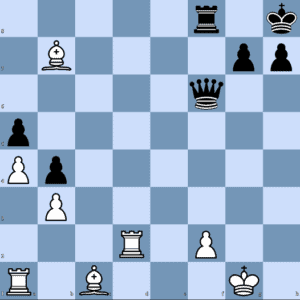
33.Rda2!! (33.Raa2 Qe7! wins a bishop) 33…Qf7 34.Bg2 Qxb3 35.Be3 Rd8 draw One possible continuation is 36.Re2 Rd1+ 37.Rxd1 Qxd1+ 38.Bf1 h5 39.Rd2 Qb1 40.Kg2 Qe4+ 41.Kg1 Qg4+ =.
Highlight the space below this line to reveal the answer.
30.Kg2 Qh2+ 31.Kf1 Qg1+ 32.Ke2 Qe1+ 33.Kd3 Rc3#.
Missed Opportunities
MAGNUS Carlsen missed some clear wins against Radoslaw Wojtaszek and was taken to a tie-break in the fourth round of the FIDE World Cup in Krasnaya Polyana just outside Sochi. Poland’s second-ranked player must have been expecting the axe to fall, but took his chance to force perpetual check when the world champion erred.
Uzbek prodigy Nodirbek Abdusattorov lived to fight another day after his opponent Vasif Durarbayli of Azerbaijan suffered an attack of nerves and was soon in a hopeless position:
V. Durarbayli – N. Abdusattorov
Philidor Defence
1.e4 e5 2.Nf3 d6 3.d4 exd4 4.Nxd4 Nf6 5.Nc3 Be7 6.Bf4 0–0 7.Qd2 Nc6 8.0–0–0 Nxd4 9.Qxd4 Be6 10.e5?! Ng4 11.Bg3?! Nxe5 12.Bxe5 dxe5 13.Qxe5 Bd6 14.Qd4? Qg5+ 15.Kb1 Be5 16.Qc5 b6 17.Qe3 Qxe3 18.fxe3 Rad8 19.Bd3 Bxc3 20.bxc3 Rd5 and 0-1 in 59 moves.
Maxime Vachier-Lagrave looks in great shape and eliminated Indian GM Rameshbabu Praggnanandhaa, 16, with this queen sacrifice. The last World Cup winner preferred 18…Rc8 19.Qa3 d6 in Akopian – Radjabov, Heraklion 2007.
M. Vachier-Lagrave – R. Praggnanandhaa
Sicilian 4 Knights
1.e4 c5 2.Nf3 e6 3.d4 cxd4 4.Nxd4 Nf6 5.Nc3 Nc6 6.Nxc6 bxc6 7.e5 Nd5 8.Ne4 Qc7 9.f4 Qb6 10.c4 Bb4+ 11.Ke2 f5 12.exf6 Nxf6 13.Be3 Qd8 14.Nd6+ Bxd6 15.Qxd6 Bb7 (White’s positional advantages are balanced by his wondering king) 16.Kd1 c5 17.Qxc5 Be4 18.Be2 d6 19.Qd4 0–0 20.Kc1 Qc7 (20…Qe7 may be better according to the computer and the game is unclear after 21.b3 a5 22.Rd1 d5 23.c5 Rfb8) 21.b3 e5? 22.fxe5 dxe5 23.Qc5 Qb7 24.Kb2 (White is consolidating, the youngster tries to take the initiative) 24…Nd5? 25.cxd5 Rfc8
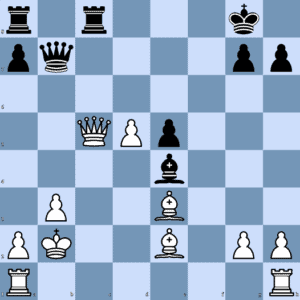
26.Rac1!! Rxc5 27.Rxc5 h6 (If 27…Bxg2 28.Rd1 Bh3 29.d6 Qe4 30.Rc3 Bd7 31.Bc4+ Kh8 32.Bd5) 28.d6 Bxg2?! (28…Rc8!?) 29.Rd1 Qe4? (If 29…Bc6 30.Rdc1 Bd7 31.Bc4+ Kh7 32.Bd5 Qa6 33.Bxa8) 30.Bc4+ Kh8 31.d7 Qxe3 32.Rc8+ Kh7 33.d8Q 1–0
Test Your Strength
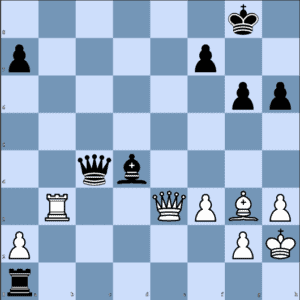
Xiong – Grandelius
White to play and win
Highlight the space below this line to reveal the answer.
30.Rb8+ Kh7 31.Be5! Bxe5+ 32.Qxe5 1-0
30.Be5 Qxb3 31.Qxd4 also works.
Carlsen Scrapes Through
MAGNUS Carlsen reached the last 16 of the FIDE World Cup after a tie-break victory over Radoslaw Wojtaszek. The world champion was held to two draws in normal time. The first Rapid was also drawn before Carlsen won the second with white.
Carlsen should have finished the match in game two. Here is the position after 24.Rf4-h4 Re5xf5.
Test Your Strength
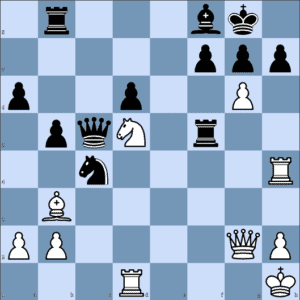
White to play and win
The game ended 25.Bc2? Qf2! 26.gxf7+ Kxf7 27.Bxf5 (After 27.Qe4 Qf3+ 28.Qxf3 Rxf3 29.Kg2 Rc8 the computer prefers White but if 30.Kxf3 Ne5+ 31.Kg3 Rxc2) 27…Qxh4 28.Rf1 Kg8 29.Rf4 Qe1+ 30.Rf1 Qe5 31.Qh3 Qxd5+ 32.Rf3 Qd1+ 33.Rf1 Qd5+ 34.Rf3 Qd1+ draw
Two matches went the distance with Sergey Karjakin narrowly overcoming Vladislav Artemiev. The match between the Uzbek prodigy Nodirbek Abdusattorov and the last Azeri standing Vasif Durarbayli was absorbing with both players winning on demand at one point. The youngster was horribly crushed at Blitz after he took the lead in the Rapid with a stunning combination.
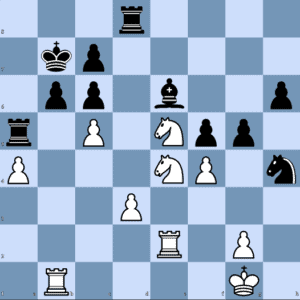
Abdusattorov – Durarbayli after 31.c5 f5? (31…f6!).
32.Nd6+!! cxd6 (32…Rxd6 33.cxd6 cxd6 34.Nxc6 Kxc6 35.Rxe6) 33.Rxb6+ Kc7 (33…Kc8 34.Nxc6 wins as do 33…Ka8 34.Nxc6 Rxc5 35.Nxd8 and 33…Ka7 34.Nxc6+) 34.Rxc6+ Kb7 35.cxd6 Ka8 36.Rb2 Bd5 (36…gxf4!) 37.Rcb6 (37.d7!) 37…Nxg2? (37…Ra7) 38.d7 Ka7 39.Rb8 Rxd7 40.Nxd7 Nxf4 41.Rc8 Ne6 (41…Nxd3 42.Rc7+ Ka6 43.Rb6#) 42.Nb6 Bb7
Test Your Strength
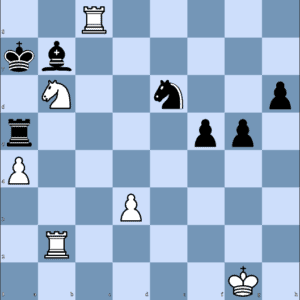
White to play and mate in three
Highlight the space below this line to reveal the answer.
Answer One: 25.Rxh7! threatens Qh3 or Rh8+! when after 25…fxg6 26.Qxg6 Rf7 27.Qh5 wins or if 26…Re5 27.Nf6# and if 26…Rxd5 27.Rg1 is simplest, intending Rxg7+ and if 27…Rb7 28.Bc2 Ne5 29.Rh8+ Kxh8 30.Qh7#.
Answer Two: 43.Ra8+!! 1-0 43…Bxa8 44.Nc8+ Ka6 45.Rb6#.
Ivic Impresses
THE TENSION was palpable in the first-leg matches in the round of 16 at the FIDE World Cup. There were seven draws and a solitary win for Haik Martyrosian, who overcame the Iranian Mohammad Tabatabaei.
Magnus Carlsen was soon worse with white against Andrey Esipenko, but steered the game towards a draw. Esipenko had a 100 per cent score against the world champion, having defeated him in their only previous game at Tata Wijk aan Zee earlier this year.
The lowest-rated player remaining in the last 16 is Velimir Ivic of Serbia, 18, who defeated world number 24 Dmitry Andreikin 2-0 in a play-off in the round of 32
V. Ivic – D. Andreikin
FIDE World Cup (4.4)
Sicilian Paulsen 25+10
1.e4 c5 2.Nf3 e6 3.d4 cxd4 4.Nxd4 Nc6 5.Nc3 a6 6.Nxc6 bxc6 7.Qd3 d5 8.Qg3 h5! 9.h4 d4 10.Nb1 Nf6 11.e5 Ng4 (Perhaps 11…Ne4 12.Qf3 Qd5 13.Bd3 Bb4+ when 14.Kf1 and 14.c3!? are pretty unclear) 12.Bf4 c5 (12…Bb4+ 13.Nd2 Bxd2+ 14.Bxd2 Qd5 15.Bf4 Qe4+ 16.Kd2! is good for White and if 16…Rb8 17.Bd3 Qd5 18.f3 wins) 13.Nd2 (White’s pieces are more active while the queen on g3 exerts pressure on the kingside) 13…Bb7 14.0–0–0 Bd5 15.Bc4 Rb8 16.b3 Nh6 17.Bxd5 Qxd5 18.Nc4 Nf5 19.Qd3 Be7 20.g3 0–0 21.f3! (White’s attack is faster) 21…Rfd8 22.g4 Nxh4 23.Bg3 (23.Rdf1 threat Bg3 also looks good) 23…Nxf3 24.gxh5 Bg5+ 25.Kb2 Bh6 (The computer finds a bizarre way to keep Black’s position together after 25…Rb4 26.Ka1 Rxc4!! 27.bxc4 Qb7 28.Rhf1 Be3 29.h6 g5 which beggars belief) 26.Rdf1! Ng5
Test Your Strength
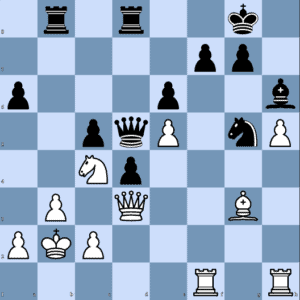
White to play and win
Ivic should have finished the match in game two:
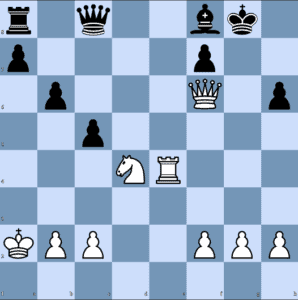 Ivic – Andreikin
Ivic – Andreikin
White to play and win
Highlight the space below this line to reveal the answers.
Answer One: 27.Bf4 Qe4 (28.Rhg1 is a decisive threat. If 27…Kh8 28.Bf4 Nh7 29.Bxh6 and Rxf7 or here 28…Nh3 29.Bxh6 Nxg1 30.Rxf7 or 27…f6 28.exf6 gxf6 29.Qg6+) 28.Rhg1 (Or 28.Qg3) 28…Qxd3 29.cxd3 Nh3 30.Bxh6 Nxg1 31.Rxg1 Kh7 32.Bxg7 Rg8 33.h6 1–0
Answer Two: 29.Re3! Qa6+ 30.Kb3! wins after 30…c4+ 31.Kc3 Qa5+ 32.Kxc4 Rc8+ 33.Kd3 Qa6+ 34.Kd2 Qa5+ 35.c3. Not 29.Re3 Qa6+ 30.Kb1 Qf1+ 31.Ka2 Qc4+ 32.b3 Qxd4 33.Rg3+ Bg7 34.Rxg7+ Kh8. Black survived after 29.Nf5 Qa6+ 30.Kb3 c4+ 31.Rxc4 Qb5+ 32.Kc3 Qa5+, later giving up his queen to set up a fortress.
Svidler Snared
PETER Svidler was eliminated in the round of 16 at the FIDE World Cup when he missed a fiendish tactical trap set by Sam Shankland in the second leg. The American won the match 1.5-0.5. Santosh Vidit was the only other player to reach the last eight without recourse to a tie-break. Carlsen defended carefully with black to draw again with Andrey Esipenko.
S. Shankland – P. Svidler
King’s Indian Saemisch Panno
1.d4 Nf6 2.c4 g6 3.h4 Bg7 4.Nc3 d6 5.e4 Nc6 6.Nge2 0–0 7.f3 e5 8.d5 Nd4 9.Be3 c5 10.dxc6 bxc6 11.Nxd4 exd4 12.Bxd4 Rb8 (12…c5 13.Be3 Nh5 14.Qd2 Ng3 is also possible) 13.Qc2 c5 14.Bf2 Be6 15.0–0–0 Nd7 (Black unmasks his main weapon on g7 and is content to let the weak pawn on d6 go) 16.Rxd6 Qa5
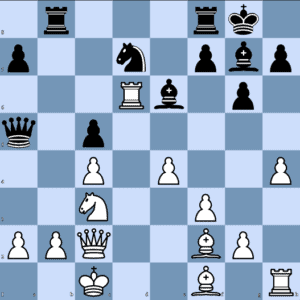
17.Be1! Ne5 18.f4 (18.b3 Rfd8 19.Rxd8+ (19.Rd5!? Nc6!) 19…Rxd8 20.Bd2 Qa3+ 21.Kd1 f5 22.Nd5 favours White according to the computer but is not without risk) 18…Nxc4 19.Bxc4 Bxc4 20.e5 Rfd8 (20…Bxa2 21.Nd5 Qb5 22.Ne7+ Kh8 23.h5 wins) 21.Rxd8+ Rxd8 22.h5! Bxa2 23.hxg6 hxg6 24.Ne4 Qb6? (An unfortunate square. 24…Qb5 25.Nd6 Qa6 26.Qxc5 Be6 is unclear; and 24…Qa6 25.Bh4 Rc8 26.Nf6+ Kf8 27.Nh7+ Kg8 (27…Ke8!?) 28.Nf6+ is a plausible outcome) 25.Bh4! Rd4 (25…f6 26.Bxf6 Rd4 27.Bxg7 Kxg7 28.f5 wins) 26.Nf6+ Kf8
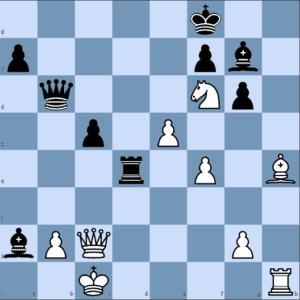
27.Bf2!! Bxf6 (White wins after, 27…Rd8 28.Bxc5+; 27…Rc4 28.Qxc4 Bxc4 29.Bxc5+ Qxc5 30.Nd7+; 27…Qb4 28.Bxd4 Qxd4 29.Qe4) 28.exf6 Qxf6 (28…Rc4 29.Rh8#) 29.Qxc5+ Rd6
Test Your Strength
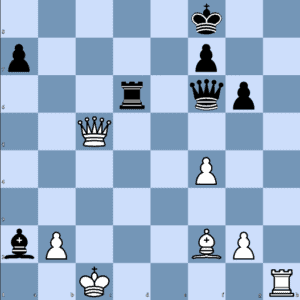
White to play and win
Round-five scores: Carlsen 1-1 Esipenko; Bacrot 1-1 Piorun; Grischuk 1-1 Duda; Vidit 1.5-0.5 Durarbayli; Fedoseev 1-1 Ivic; Tabatabaei 1-1 Martirosyan; MVL 1-1 Karjakin; Svidler 0.5-1.5 Shankland.
Highlight the space below this line to reveal the answer.
30.Qc8+ 1–0 30…Ke7 31.Bh4; 30…Qd8 31.Rh8+; 30…Rd8 31.Rh8+ Qxh8 32.Qxd8+ Kg7 33.Bd4+.


